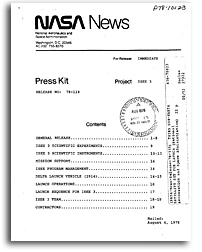 The ISEE (International Sun-Earth Explorer) program was an international cooperative program between NASA and ESA to study the interaction of the solar wind with the Earth’s magnetosphere. The program used three spacecraft, a mother/daughter pair (ISEE 1 and 2) and a heliocentric spacecraft (ISEE 3, later renamed ICE).
The ISEE (International Sun-Earth Explorer) program was an international cooperative program between NASA and ESA to study the interaction of the solar wind with the Earth’s magnetosphere. The program used three spacecraft, a mother/daughter pair (ISEE 1 and 2) and a heliocentric spacecraft (ISEE 3, later renamed ICE).
The three spacecraft carried a number of complementary instruments for making measurements of plasmas, energetic particles, waves, and fields. ISEE 1 and 2 were launched together and followed the same highly elliptic Earth orbit (23 Re by 270 km), with a small but variable separation between the two to separate spatial from temporal effects in the observations. Both spacecraft re-entered the Earth’s atmosphere in September 1987.
Later, the spacecraft was re-named the International Cometary Explorer (ICE). The primary scientific objective of ICE was to study the interaction between the solar wind and a cometary atmosphere. As planned, the spacecraft traversed the plasma tail of Comet Giacobini-Zinner on 11 September 1985, and made in situ measurements of particles, fields, and waves. Termination of operations was authorized 5 May 1997.
An extended ICE mission was approved by NASA in 1991 for the continued investigation of coronal mass ejections, continued cosmic ray studies, and coordinated observations with Ulysses.